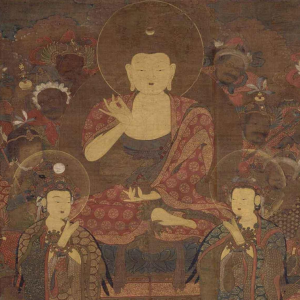Thursday
Dying & Death Classes on Shambhala Online
By Alley Smith

Death is the greatest of all teachers. –The Buddha
Shambhala Online has been offering a variety of courses on topics related to dying and death. These topics enable the sangha and outside community members to gather and think about death, engage in contemplative practices, and toil with topics such as fear, anxiety, the unknown, and how to have conversations about death.
The Shambhala community is gathering with purpose: to understand the dying process, to recognize and articulate the role of spiritual, religious and existential support, practices, and cultural norms within the modern Buddhist context. The result is tremendous openness and courage to face the inevitable and unknown in a gentle and relaxed way.
As Chögyam Trungpa Rinpoche says, Life is painful with an occasional speck of pleasure. We are born, we get old, we experience sickness, and, last but not least, we die. We are each waiting to die. I’m afraid that is the bad news. Whether you are young or old doesn’t make much difference – everybody will eventually die. So now is the time to do something with your life. We are not interested in developing eternity or immortality, or in preventing being sick or being born. We are interested in doing something while we are alive, while we are breathing, while we see the beauty of the snow, the flowers, the blue sky, the sunshine and many other things we can imagine.
While we are alive we can explore our personal belief systems about dying and death, our struggles, vulnerabilities, strong emotions, personal values, needs, and much more. Death has so much to teach us. Even as the Buddha was dying, he taught that suffering (dukkha) comes from not living in accordance with the truth of impermanence and interdependence. Death itself is a profound spiritual transmission.
Students have been gathering across the global community at Shambhala centers in Seattle, Dallas, Halifax, Los Angeles, and Philadelphia to offer support and practice advice. Communities are interested and invested in doing something while they are alive, while breathing, to be embraced by the sangha, to be met with unconditional kindness and the warmth of the Great Eastern Sun.
In the end, everything is left up to the individual. Therefore, most Buddhists do not take the truth of impermanence half-heartedly. Whether we are studying the Tibetan Book of the Dead, teachings of Amitabha Buddha, the Pure Lands, Sukhavati, Bodhichitta, the Bardos, and a vast array of teachings, we must do as many great Rinpoches and Tibetan lamas suggest. Engage in whichever practices are clearest, familiar, and most vivid on our deathbeds.
While we are alive we must be willing to face old age, sickness, and death with confidence and fearlessness. We must abandon any notion of resentment and attachment. Ask yourself, why would the Buddha say, Death is the greatest of all teachers? What can we learn from his words? In the end, as Trungpa Rinpoche says, “It’s up to you sweetheart.”
Shambhala Online would like to invite you to attend any one of these upcoming sessions in 2025:
Fear & Fearlessness: Navigating Life & Loss
March 27. During this online session, we will explore Chögyam Trungpa Rinpoche’s teachings on “Fear and Fearlessness” from the timeless classic, Shambhala: The Sacred Path of the Warrior.
The Buddha’s Discourse on Teachings to Be Given to the Sick
November 1. During this mini-retreat, we will read and explore the Buddha’s Discourse on the Teachings to Be Given to the Sick. We will examine traditional Buddhist teachings on the six senses, six sense objects, six elements, the five aggregates, and more.
Making Friends with Death & Dying: Support Group (1st Monday night of every month)
Next session April 7. Support group sessions will include a short talk, meditation practice, and an open forum to discuss personal experiences with old age, sickness, death, grief and bereavement. All are welcome. We respect your privacy. These sessions will not be recorded.
The 49 Day Ceremony: A Celebration of Life & Death
December 13. Join Chaplain Alley Smith for a 3-hour online mini-retreat as she guides participants into a deeper understanding of the 49 Day Ceremony and the common Buddhist practices and rituals that follow someone’s death – all within a modern Buddhist context.
Alley Smith (she/her) is an ordained Zen Buddhist Chaplain, scholar, researcher, and lecturer who serves at a college and university. Alley is deeply influenced by Pure Land Buddhism and Vajrayana. She has been a member of Shambhala and Zen since 1999. Alley works in the funeral industry in Vermont. She teaches a number of courses on Shambhala Online.
Entries filed under Dharma Teachings
Moving Out of the Dark Age – HIGHLIGHT
By Sakyong Mipham According to many wisdom traditions, we are in a dark age. Over a thousand years ago, Padmasambhava, the great teacher who brought Buddhism from India to Tibet, predicted that this particular dark age would be distinguished by our increasing cleverness. We would create myriad ... continuePosted August 22, 2010 by
The Great Assembly and the Yijing (I Ching) – HIGHLIGHT
Shastri Daniel Hessey applies the wisdom of the I Ching to understand the power of the Scorpion Seal Assemblies. The Scorpion Seal Assembly seen through the eyes of the Ancestral Sovereigns of China The way of Shambhala originated when the Buddha first transmitted the Shambhala dharma to King ... continuePosted August 7, 2010 by
Generosity and Creating Enlightened Society – HIGHLIGHT
By Walker Blaine This article was written in preparation for the Great Mandala Offering. The Great Mandala Offering is a sangha-wide event occurring this weekend at Shambhala Mountain Center. It will be broadcast live by Shambhala Online to Shambhala Centers throughout the world. Cultivating a path of warriorship ... continuePosted July 16, 2010 by Walker Blaine
Shambhala as a Terma Lineage – HIGHLIGHT
By Acharya Judith Simmer-Brown This article is based on an address to the Shambhala Teachers’ Academy held at Dechen Choling in September, 2009. Originally released on the Shambhala Times last December, it is now being republished in conjunction with the release of The Great River of Blessings, ... continuePosted July 3, 2010 by
Zen et Tantra: En Francais – HIGHLIGHT
Par Acharya David Schneider, traduit par Vincent Bardet To commemorate the release of The Teacup and The Skullcup in French, Acharya David Schneider gave a talk in Paris. This article provides some background. Click here to read the article in English. Soon, we will feature the ... continuePosted June 29, 2010 by
Zen and Tantra: In English – HIGHLIGHT
By Acharya David Schneider To commemorate the release of The Teacup and The Skullcup in French, Acharya David Schneider gave a talk in Paris. This article provides some background. In the coming days, we will publish this article in French and feature the ... continuePosted June 25, 2010 by
Karmapa Streaming Live Today on New Website – HIGHLIGHT
His Holiness the 17th Karmapa will be streamed live from Dharmasala beginning today or tomorrow, June 17-18, depending our your location. He will be teaching on Dhagpo Rinpoche’s (Gampopa’s) Lam-chog Rinchen Trengwa or Precious Garlands of Supreme Path.The series of talks will be simultaneously translated into ... continuePosted June 17, 2010 by
Be Pragmatic in Practice – HIGHLIGHT
By Sakyong Mipham Rinpoche As the great Zen teacher Suzuki Roshi said, “We are completely perfect, but we need a minor adjustment.” We have everything we need, but we have to hone it. Meditation is that honing process. What we are honing is our intention. Meditation is not ... continuePosted June 13, 2010 by
Rainbow of Confidence in Boulder – HIGHLIGHT
By Jennifer Holder With many blessings and the help of participants, I was able to capture photos of Saturday evening’s stunning moment on my iPhone and report it to the mandala this morning. Click on the photos to see them more clearly and in a larger ... continuePosted May 30, 2010 by Jennifer Holder
White Dove, Black Crow – HIGHLIGHT
From the column Dharma Snacks, by Cynthia Kneen I remember how a Japanese Buddhist monk in brown robes used to walk the streets of Boulder, Colorado with a strong open posture, uplifted gaze and good stride, beating a small drum. He walked all over town. People knew ... continuePosted April 22, 2010 by
Cultivating a Healthy Sense of Self – HIGHLIGHT
By Sakyong Mipham In his journey toward enlightenment, the Buddha saw that human existence is characterized by three qualities: impermanence, suffering, and selflessness. He discovered that we suffer because we try to make ourselves solid and permanent, while our fundamental state of being is unconditionally open and ... continuePosted April 10, 2010 by
Vidyadhara on Shambhala Households – HIGHLIGHT
[caption id=”attachment_15163″ align=”alignleft” width=”300″ Q. How would you describe the Shambhala household? VCTR: Well, very simple. Good household washes every dish and doesn’t soak them, waiting for somebody else to clean-up after you. After your meals, wash them right away. Clean after you each time, so you ... continuePosted April 5, 2010 by
Tender Warriorship and the Good Nightmare – HIGHLIGHT
On the occasion of the Parinirvana of the Vidyadhara, Chogyam Trungpa Rinpoche, we offer a talk he gave at the Naropa Summer Seminar on August 20, 1979. This is the first time it has been published, and we would like to offer special thanks to the ... continuePosted April 4, 2010 by
Lineage as the Direct Antidote for Now – HIGHLIGHT
This twentieth Parinirvana Day Message from the Sakyong, Jamgon Mipham, was read to all Shambhala centres in 2007. One of my early memories is of a young man walking toward me down a village road in India. He was about twenty-eight years old, handsome, beaming, and ... continuePosted April 3, 2010 by
Living in a Living World – HIGHLIGHT
You are invited to view teachings from Acharya Moh Hardin and Sangyum Cynde Grieve, courtesy of the Dallas Shambhala Meditation Center. You may view Part One in the series on this page, and then click here to view Parts Two-Six January 23-24, 2010 Being vs. Becoming continuePosted March 21, 2010 by
![]() RSS feed for the Dharma Teachings category
RSS feed for the Dharma Teachings category
View all posts from authors in Dharma Teachings: jillian_johnson



















